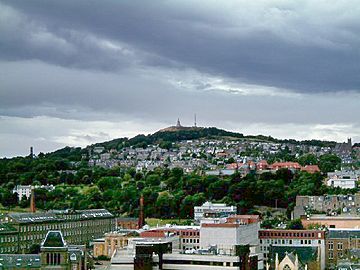Dundee Law facts for kids
Quick facts for kids Dundee Law |
|
|---|---|

Dundee Law as seen from The Old Steeple
|
|
| Highest point | |
| Elevation | 174 m (571 ft) |
| Listing | Tump |
| Geography | |
|
Lua error in Module:Location_map at line 420: attempt to index field 'wikibase' (a nil value).Lua error in Module:Location_map at line 420: attempt to index field 'wikibase' (a nil value).
|
|
| Location | Dundee, Scotland |
| Geology | |
| Age of rock | ~400-415 million years |
| Mountain type | Crag and tail, Volcanic sill |
Dundee Law is a famous hill right in the middle of Dundee, Scotland. It's the highest point in the city, standing tall at 174 meters (about 571 feet) above sea level. This hill is actually what's left of an ancient volcano! It was formed around 400 million years ago from volcanic activity. Today, with a large war memorial at its top, it's a very noticeable landmark in Dundee.
Contents
How Dundee Law Was Formed
Dundee Law gets its name from a Scots word meaning a prominent hill. It's a great example of a volcanic sill. Imagine hot, melted rock (lava) pushing its way through cracks in older rocks, like Old Red Sandstone. This happened millions of years ago, far to the west of Dundee.
Over a very long time, rain, wind, and ice slowly wore away the softer sandstone. This left behind the harder volcanic rock, which is what we see today as Dundee Law. During the ice ages, huge glaciers moved across the land. They dropped lots of rocks and dirt around the base of the hill, creating what's called a crag and tail shape. The way the ice moved also made the northern and eastern sides of the Law less steep.

A Look Back in Time
Dundee Law has a long and interesting history!
Early Settlers and Romans
People have been using the Law for a very long time. We know this because archaeologists have found signs of burials from about 3500 years ago. During the Iron Age, it was home to a Pictish settlement. The Picts were ancient people who lived in Scotland.
Even the Romans might have used Dundee Law. Roman pottery has been found there, suggesting they used it as a lookout spot in the first century AD.
Important Historical Events
The Law was the scene of a big event on April 13, 1689. A Scottish nobleman called Viscount Dundee raised a special flag (the Stuart Royal Standard) on the Law. This moment marked the start of the first Jacobite rising, a series of battles to put the Stuart family back on the throne.
The Railway Tunnel
Did you know there's a railway tunnel running right through Dundee Law? It was once part of a railway line that went to Newtyle. This railway line closed in the 1960s. In 2014, some people started a campaign to open the tunnel again, maybe as a cool new tourist attraction!
The War Memorial
At the very top of Dundee Law, there's a large war memorial. It was first shown to the public on May 16, 1925. This memorial remembers all the brave people who died in both World War I and World War II.
Interestingly, the Mills Observatory was first planned to be built on the Law. But the plans changed, and the war memorial was built there instead. The observatory was then built on Balgay Hill and opened in 1935.
Lighting Up the Law
The war memorial on Dundee Law is lit up with a big flame on certain important days. This flame is a powerful symbol. It's lit on:
- September 25: To remember the Battle of Loos, where many soldiers from the local Black Watch regiment died.
- October 24: For United Nations Day.
- November 11: For Armistice Day, which marks the end of World War I.
- Remembrance Sunday: A day to remember all those who have died in wars.
Modern Times
In recent years, Dundee Law has appeared in popular culture. It was featured in the TV show Traces.
In 2022, something fun happened during the Dundee Summer Streets Festival. A large sign, like the famous Hollywood sign, was put up on the Law. It spelled out "Beanotown," which is the made-up town from The Beano comic. The Beano is published in Dundee, and the sign was part of the festival's theme!
In 2024, the well-known newspaper The Times listed Dundee Law as one of the best places in Scotland for amazing views. It was ranked fifth!
Gallery




